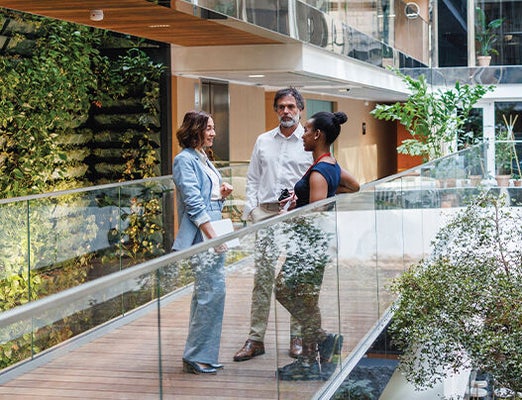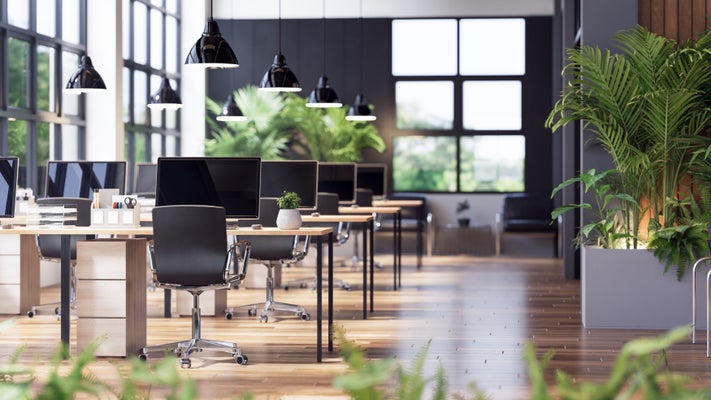Total Property -
New season for the office

The complex interplay of strategic, economic and operational catalysts is driving the corporate office market around the world as occupiers seek to balance growth and innovation with cost control.
Leading international real estate consultancy firm Knight Frank has released (Y)our Space – Australian and New Zealand Edition Q1 2025, looking at the trends shaping corporate workplaces and the structural shifts that occupiers face.
As Bayleys’ global real estate partner, Knight Frank called on the Bayleys occupier strategy and solutions team to coordinate input from Auckland-based corporates, with their take on office space priorities and challenges adding to the Trans-Tasman conversation.
Identifying and implementing space that works harder for people, performance and purpose is how Knight Frank summarises the current office market globally.
Increasingly, real estate is seen as a strategic device for supporting organisational culture, productivity, and talent attraction. Bayleys national head of occupier strategy and solutions, Steve Rendall says despite economic and workforce challenges, it is becoming increasingly clear that the office is here to stay.
Cost front of mind
“There are plenty of reasons to be optimistic – occupancy levels are improving and some stability is returning to the market. The office is not going anywhere and has a good future, but there are hurdles to confront.
“When asked to consider their real estate strategies over the next three years, occupiers surveyed for the (Y)our Space report said that enhancing the workplace experience and reducing costs were the two most significant issues being faced.
“Budgetary considerations are far more pressing now than in the last few years, with almost half of the respondents targeting real estate cost reductions – a reflection of the generally subdued economic climate and greater corporate/stakeholder prudence.”
Cost management is a feature of every leasing deal Bayleys does, says Rendall.
“Chief executives and chief financial officers are highly focused on the bottom line and while the flight to quality we’ve witnessed from leading businesses seems at odds with this, Auckland has a wide range of opportunities across price points.
“Occupiers could be surprised at what they can find and there are solutions to be found to most problems or challenges, with access to capex a prime example. Landlords want their buildings occupied, and we’re seeing some innovative funding deals being offered. There are also plenty of premises available with high quality existing fitout that can be repurposed.”

Source: Knight Frank (Y)our Space Australian & New Zealand Edition Q1 2025
Bayleys national director strategic business development, Davina Henderson works alongside the firm’s key business units and with major clients to drive growth, innovation and high-value strategic outcomes.
“Bayleys’ scale allows us to uncover all viable, workable options for occupiers, helping them to make the best real estate decisions for their business,” says Henderson.
Despite residual pandemic-related disruption and some significant downsizing evident in parts of the market, 62 percent of Australian and New Zealand respondents in the survey have not relocated premises in the past three years, and most expect their office footprint to remain stable – again a by-product of economic uncertainty, along with high relocation costs.
“Of those that have moved in the past three years, 80 percent did so to improve building quality with the desire for better amenities, an optimised workplace experience, and targeted sustainability outcomes being the main drivers,” says Rendall.
“Space is being used in different ways today, and while flexible work models are now entrenched for corporate occupiers, the centralised office remains vital for most businesses with many tenants opting to better use the space they have rather than relocate.
“Mid-sized businesses are not as reliant on having the ‘flashest’ premises, but access to public transport and staff safety are very real considerations. For this segment of the market, finding premises where they can re-use existing fitout is a smart financial and sustainable move.”
Engagement imperative
More than half of the organisations canvassed in the (Y)our Space survey have formal or informal return-to-office mandates in place, with a minimum of three days per week in the office being standard practice.
Mirroring global findings by Knight Frank, the underutilisation of space is a key issue with the mismatch between hybrid workstyles and existing workplace layouts fuelling demand for purpose-driven, flexible space that can respond to shifting staff patterns.
“In Auckland, the return to the office is a mixed bag, but I would say that corporates are more confident now about ‘mandating’ compulsory attendance.
“Businesses haven’t been sure how to communicate expectations around workplace attendance to staff, with the desire to retain talent always front and centre. However, a softer employment market may go some way in mitigating this as employees recognise the value of a good job – and there seems to be greater acceptance that being in the office for prescribed days each week comes with the territory.”
A push to enhance productivity and facilitate collaboration among teams saw 61 percent of survey respondents changing workplace layouts, creating more meeting rooms and informal collaboration zones to flex to new workstyles and to attract talent back to the office. Workplace amenities like food and beverage options, cycle storage, and wellness centres are increasingly important, as are spaces that blend work and social connection. “Workforce engagement is paramount for businesses and although recent history shows us that many roles have remote capability, it has not always been optimal for business productivity and team culture.
“Having a commute-worthy workplace is important. It’s no longer enough to simply offer a desk – a modern workplace aligns work styles with workspace and reframes the office as a centre for innovation and engagement.”
The (Y)our Space report also highlighted that AI is reshaping workplace design and function and is being integrated into real estate decision-making – from space planning and occupancy analytics to energy management, and by enabling flexible, tech-enabled environments focused on creativity and collaboration.

Source: Knight Frank (Y)our Space Australian & New Zealand Edition Q1 2025
Green drivers
Sustainability is a key driver for corporate space decisions with 95 percent of respondents in the Australia-New Zealand survey saying it will influence their real estate strategy over the next three years. Green leases are on the rise, with landlords and occupiers needing to work together to optimise sustainability outcomes and to meet stakeholder expectations and goals.
Knight Frank’s cross-border research in the office sector found that while ESG is integrated into long-term strategies, the more compelling and immediate focus currently is on cost and efficiency with only seven percent of global (Y)our Space survey respondents listing ESG as their top portfolio challenge.
Bayleys head of building consultancy, David Guy says sustainability is integral to the office sector today and his team works with landlords and tenants to formulate a roadmap to improvement across a building's lifecycle by providing comprehensive technical due diligence and advisory services.
“For landlords, we can identify statutory compliance issues, assess fitness for purpose, and coordinate specialist teams including structural engineers and service engineers.
“Working with tenants, we can identify issues such as deferred maintenance, condition of the building fabric and services, and assess whether the building is fit-for-purpose for their business.”
The (Y)our Space report says a sustainability-first approach is driving corporate real estate decision-making as occupiers look to achieve carbon-neutral operations.
“We appraise the environmental performance of a building as part of our technical due diligence advice,” says Guy.
“A Green Star rating is a globally acknowledged system that defines benchmarks for creating healthy, resilient, and environmentally friendly buildings and evaluates the environmental performance of buildings across various categories, including energy efficiency, water usage, indoor environment quality, and materials used.
“For building owners, achieving a Green Star certification contributes to lower operating costs with certified buildings using 66 percent less electricity and 51 percent less potable water than average buildings, and sustainable buildings often having higher market value and attracting premium tenants.
“Other benefits include improved occupier health and wellbeing, fewer greenhouse gas emissions, and futureproofing against environmental and regulatory changes.”
Climate alignment
Mandatory sustainability reporting came into effect in Australia in January this year for entities meeting prescribed size thresholds and is far broader than the equivalent New Zealand mandatory climate-related disclosures (CRD) regime. Under the Australian mandates, large-scale occupiers meeting two out of three criteria based on consolidated revenue, consolidated gross assets and employee numbers are required to prepare an annual sustainability report.
“Given New Zealand's proactive stance on climate-related disclosures, it is likely that sustainability reporting requirements will potentially align more closely with Australia's broader regime in the future with audit-ready data becoming the best-practice benchmark,” explains Guy.
“Our existing CRD regime which mandates sustainability disclosures by large NZX-listed issuers, registered banks, licensed insurers, credit unions, building societies, and managed investment scheme managers was among the first globally to introduce mandatory standards, and aligns with international recommendations such as those from the Task Force on Climate-related Financial Disclosures.”
Collaboration between landlords and tenants to address sustainability within a building over time is the foundation of green leases. Guy says aside from the more obvious energy-saving and efficiency pillars, sustainability challenges around make-good and fitout are also under the spotlight.
“These challenges include waste generation, resource consumption, and environmental impact, but there are ways to mitigate these effectively.
“Prioritising recycling and reusing materials, controlling dust and chemical emissions and ensuring proper disposal of hazardous materials, using energy-efficient equipment and minimising water usage, and selecting environmentally friendly materials for new fit outs can all help mitigate the environmental impact.”